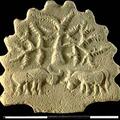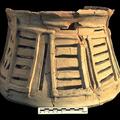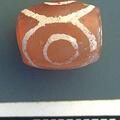Molded tablets from Trench 11 at Harappa sometimes have impressions on one, two, three or four sides. This group of molded tablets shows the complete set of motifs.
344 posts, also carried on our Facebook page, about the ancient Indus Valley civilization, including important news, research and occasional visits to museums with ancient Indus artifacts.
May 22, 2013
The great bath at Mohenjo-daro at dawn and in context. Surrounded by a brick colonnade, it measures approximately 12 meters north-south and 7 meters wide, with a maximum depth of 2.4 meters.
May 5, 2013
Ernest Mackay writes (1931): "The boss was then carefully rounded off after the groove that always runs across its center had been roughly made by a V-shaped cut.
Apr 22, 2013
Loosely included under the rubric of terracotta "figurines" are the terracotta masks found at some Harappan sites. This mask clearly has a feline face with an open mouth with exposed fangs, a beard, small round ears and upright bovine horns.
Feb 28, 2013
A seal from Mohenjo-daro found by Wheeler in the 1920's. From his 1931 text: "The plant on the [seal] has been identified as a pipal tree, which in India is the Tree of Creation.
Jan 5, 2013
First it is necessary to make the faience paste and the steatite molds. Then the paste is formed into a rectangle and impressed on both sides by the molds.
Dec 12, 2012
Miniature mask from Mohenjo-daro of bearded horned deity. The face is made from a mold and thumb impressions from pressing the clay are visible on the back. The mouth is somber and the long almond shaped eyes are open.
Dec 9, 2012
A unique mold-made faience tablet or standard was found in the eroded levels west of the tablet workshop in Trench 54 at Harappa in 2000. On one side is a narrative scene with two bulls fighting under a thorny tree.
Dec 1, 2012
Reconstructed bird cage found at Harappa in 1999. On the other side it has a slot for a terracotta door, but no top was found. The exterior was decorated with red slip and black paint.
See also Broken Terra Cotta Bird Cage and Bird Whistle.
Nov 16, 2012
Topography of the ancient site of Harappa, including smaller mound in the top right still settled today, by Bill Belcher. See also Mark Kenoyer's comprehensive article The Ancient City of Harappa.
Nov 14, 2012
Black steatite wig from late Period 3C deposits in Trench 43 found at Harappa.
Nov 10, 2012
Another skeleton from Harappa, this from Marshall's excavations published in 1931. He writes: "At Harappa several examples of this mode of sepulture [complete inhumation], which are unquestionably orthodox, have already been exposed in the lower stratum of
Nov 5, 2012
A carnelian bead found at Harappa artificially colored with white lines and circles using a special bleaching technique developed by the ancient Indus inhabitants. For more information read Kenoyer and Vidale's paper Carnelian Bead Production in Khambat,
Oct 24, 2012
Fragments of a grooved red sandstone object or objects were found in the upper disturbed levels at Harappa.
Oct 21, 2012
Pedestaled vessels, such as this hand-built painted bowl-on-stand of the Ravi Phase found at Harappa, appear to be the predecessors of a vessel form that becomes more common during the later Kot Diji and main Harappan Phases.
See also Indus Pointed Base















